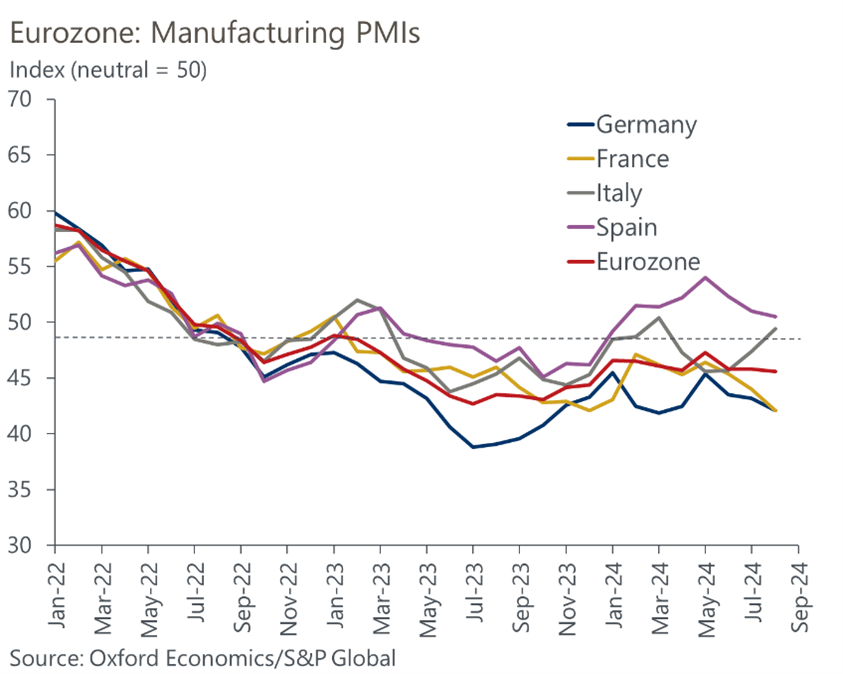Description:
Demand in the Eurozone is gradually recovering, showing noticeable improvement over the past six months. While the trend is expected to continue, uncertainties related to US trade policy may impact the recovery. The region’s future prospects are expected to strengthen through the European rearmament plan and Germany’s upcoming investment strategies.
Keywords:
Eurozone, economic recovery, demand, US trade policy, European rearmament, German investments, Eurozone growth, European economic policies.
The Eurozone has witnessed a steady improvement in demand over the past six months. This gradual recovery is not only noticeable but also significant for the region’s economic trajectory. However, the pace and sustainability of this recovery remain subject to global economic dynamics, particularly the ongoing uncertainties surrounding US trade policy. While the Eurozone continues to navigate these uncertainties, the decisions made so far have not altered the trend of improvement, offering cautious optimism for the near future.
Economic Recovery in the Eurozone: A Gradual but Steady Growth
For nearly half a year now, the Eurozone has experienced a significant yet gradual recovery in demand. This upturn is especially evident in sectors like manufacturing and retail, where activity levels have been steadily increasing. Although growth is still relatively slow, the continuous positive momentum has sparked hope that the region could soon return to pre-crisis economic levels. Analysts are cautiously optimistic, noting that the region’s ability to recover despite global economic challenges is a promising sign of resilience.
The Role of US Trade Policy in Shaping Eurozone Demand
Despite this positive trend, several challenges lie ahead, particularly the uncertainties related to US trade policies. The US remains a major global economic player, and its decisions regarding trade tariffs, imports, and international agreements can have far-reaching implications. The Eurozone’s export-driven economies, particularly Germany, are closely tied to the global trade system, making them vulnerable to shifts in US trade policy. While the current US administration’s stance on global trade remains unclear, the region is bracing for potential disruptions that could delay or alter the pace of recovery.
For more information on the impact of US trade policy, you can visit this link on trade policy and international economics published by the World Trade Organization.
Strengthening Economic Momentum: The European Rearmament Plan
In the medium term, one of the key strategies to ensure the continued growth of demand in the Eurozone is the European rearmament plan. This initiative, which focuses on increasing defense spending across the European Union, is expected to have a significant impact on economic activity. The plan will not only bolster the defense sector but also stimulate technological advancements and manufacturing capabilities within the region. These efforts are likely to lead to a more diversified and resilient economic landscape, with long-term benefits for employment, innovation, and economic stability.
Learn more about European defense strategies by visiting European Defense Agency.
Germany’s Investment Plans: A Catalyst for Eurozone Recovery
Germany, as the largest economy in the Eurozone, plays a crucial role in driving regional growth. The country’s investment plans, which include a strong focus on infrastructure development and green energy projects, are expected to have a considerable impact on economic recovery. These investments are part of a broader strategy to modernize Germany’s industrial base while simultaneously addressing environmental challenges. As these projects take shape, they will provide a boost to demand not only within Germany but across the Eurozone, reinforcing the region’s economic momentum.
In addition to infrastructure, Germany’s shift towards renewable energy and sustainability projects will open up new avenues for economic growth. The transition to green energy is seen as a critical element in ensuring long-term economic stability and growth. As Germany moves forward with these investments, the entire Eurozone stands to benefit, positioning the region as a leader in sustainable development and technological innovation.
For a deeper dive into Germany’s energy policies, check out this link from the German Ministry for Economic Affairs and Energy.
The Medium-Term Outlook for the Eurozone Economy
Looking ahead, the medium-term outlook for the Eurozone appears positive, with key initiatives such as the European rearmament plan and Germany’s investment in sustainable infrastructure expected to drive demand and economic activity. The implementation of these plans will likely create a positive feedback loop, where increased investment and job creation lead to higher consumer spending, which in turn supports further economic recovery.
However, it is essential to recognize that this recovery remains fragile. Global economic uncertainty, particularly in relation to US trade policy, could undermine the progress made thus far. Moreover, geopolitical tensions or unexpected financial shocks could disrupt the Eurozone’s recovery trajectory. While the outlook is cautiously optimistic, there is a need for continued vigilance and adaptation to ensure that the Eurozone remains on a path toward sustained growth.
Conclusion: The Road Ahead for the Eurozone
In conclusion, the Eurozone’s recovery is gradually gaining traction, with positive trends in demand and investment. The region’s ability to weather the challenges posed by global economic uncertainties, including US trade policy, will be crucial in determining the pace and sustainability of its recovery. With strategic investments in defense, infrastructure, and green energy, the Eurozone is well-positioned to foster long-term economic growth. However, careful attention to external risks and internal dynamics will be essential in maintaining this positive momentum.
For more articles on the Eurozone economy and related topics, visit our website.




